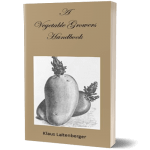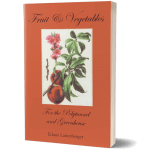Book – ‘The Self-Sufficient Garden’
€14.95
Description
Book – ‘The Self-Sufficient Garden’ is a practical guide on how to grow the 30 most common vegetables. It illustrates how to get a year round supply of fresh vegetables from your own garden.
This book is an essential guide to growing and maintaining a self-sufficient garden. It incorporates both sustainability and practicality. And it demonstrates the possibility to grow in a way that promotes biodiversity whilst producing a sizeable harvest.
Book – ‘The Self-Sufficient Garden’
Introduction
The Self-Sufficient Garden conveys the fundamental preparatory measures for beginning a self-sufficient garden and it can be referred to for precise instructions on spacing and storing your vegetables.
The book is based on a specific model which can be applied to any plot. Detailing the thirty most important vegetable crops, it is a condensed formula for self-sufficiency. It is also written in consideration of the traditional and modern obstacles facing gardeners today, The ‘Self-Sufficient Garden’ reaches for a natural and productive symbiosis.
Foreword of the Book – ‘The Self-Sufficient Garden’
I grew up in a small village in south Germany next to the beautiful Neckar River winding its way along steep vineyards. The water so polluted that we were not allowed to even touch it. Then the neighbouring Black Forest started to die.
In April 1986, the Chernobyl disaster happened and the nuclear cloud came directly over us. Life and business continued as usual for most people.
Nothing was the same for me after that. I knew that a lot of things needed to change. Many things did change – the Neckar River is a lot cleaner now, there are fish again and some of the forests are recovering.
Reason for writing this book
I’m writing all this because I can see the same problems appearing here in this beautiful island of Ireland. Our rivers and lakes are polluted with numerous chemicals (weed killers and fertilisers)
These chemicals have even found their way into the groundwater and are polluting wells.
To have polluted water in a country with such a low population and so little industry is beyond comprehension. The solution would be so simple and effective and we could swim and drink water from every lake and river in Ireland.
I know I am too extreme – I would ban the use of harmful chemicals that are polluting our environment.
I can sense a major shift coming. I’m rejuvenated by a strange positivity and I can feel that change is coming soon. So many people now realise that we have to live in harmony with nature – that we are a part of nature. We can no longer view nature simply as a means for providing resources for our industries.
What scares me though is how we have become so separated from nature. Half of the people in the world now live in cities, most people couldn’t identify trees or wildflowers, children get less outdoor activity than what is given to prisoners for mental health, phones, gadgets, games – everything has become so fast.
On a Positive Note
This was one of the few good side-effects of Covid 19 – the pause button was pressed. It was as if nature – or Mother Earth – asked us to sit back and reflect. I’m sure millions of people have re-discovered the little miracles of nature during this time and will find it difficult to get back into the ‘fast’ world.
Grow your own food
A good start is to grow some of our own food. To connect with nature in the garden and then get a glimpse of the miracles that surround us. The miracle of a seed germinating or a potato sprout emerging from the soil. Digging a basket of potatoes, cooking them and eating a delicious meal with your family. It is so simple but yet – you worked for it and it will nourish you infinitively more. As well as that – you possibly left this plot of land in a better state than when you started.
There are more and more people who are growing their own food again. Some are. even starting small market gardens. I recently asked a young organic market gardener why she chose this profession as there are far easier ways of making a living. Her answer was “because it’s cool”. This is a great shift in mindset and hopefully reflects a much wider population.
Up to quite recently, food growing was considered old-fashioned and too much like hard work. It’s easier to buy food from a shop. Now it’s cool to grow your own food and you’ll get the extra benefit of good physical exercise and fresh air. The times are changing.
All you need is 200m² – 400m²
When you ask people to guess how much land you would need to feed a family with vegetables for most of the year the answer is often an acre or two.
This is completely wrong. In this book I’ll outline three vegetable cropping plans ranging from 50m² to 400m². A plot of about 200m² (partial self-sufficiency) to 400m² (full self-sufficiency) would be enough to feed a family of two adults and two children.
And 400m² is 1/10 of an acre (an acre is about 4,000m²). It is fantastic news that one acre can feed 10 families or 25 families per hectare (one hectare is 10,000m²).
Scope of the Book – ‘The Self-Sufficient Garden’
In this book I only cover the 30 most important vegetable crops. Many minor crops have been omitted only because it would make the book and the planning too complex. You can easily fit them into your crop plan – in a garden there is always some extra space.
One important thing to realise is that not all crops will be perfect – there will also be some complete failures of certain crops and this happens to the best of growers.
The crop plans are based on a family of 2 adults and 2 children that consume a lot of vegetables. The first crop plan is for a small garden and specialises only on high value and value for space crops, the second crop plan is for easy to grow staple crops that will fill your store. The third crop plan is for the completely self-sufficient garden with 300m² outdoor garden and 90m² of a polytunnel. If all crops are performing well there will be a lot vegetables to give away and new friends to be made.
How much time is needed?
The first two gardens can be done with very little time commitments – a few days to get it all started in spring and then just a couple hours in the evening or half a day at the weekend.
The completely self-sufficient garden, however, requires a more concerted family effort. If you haven’t a garden yet it will take time (or good machinery) to get the ground ready and the beds formed. After that it will take 2 people for one full day at the weekend and half an hour some evenings to maintain the garden.
Throughout the book, I’m quite precise with figures and sowing dates just because I think this is helpful for people to get started. But obviously these are not written in stone. Try them out, modify the techniques and sowing dates as it suits you. The beauty of gardening is that there are many right ways of doing things. No two gardeners will ever be the same. After reading a number of books from different authors, visiting gardens and trying it all out yourself you will be in danger of getting confused so much conflicting information thrown at you from all sides. Don’t worry – simply pick out the best tips and create your own method that suit you and your garden.
John Seymour
Obviously I couldn’t write a book on self-sufficient gardening without mentioning the hero and pioneer of Self-Sufficiency – John Seymour. I was so lucky to have met him once. He came up to Leitrim and stayed with us for the weekend while giving a weekend course at the Organic Centre. I’ll never forget the philosophical discussions and many laughs. One thing I clearly remember though was his advice – “Always and wherever you are – be part of the whole community – people and the world around you”. He said it far more eloquently than that.
John Seymour (author) – Wikipedia
Why not subscribe to my monthly gardening newsletter?
https://greenvegetableseeds.com/newsletters/
A good information for all gardening news is the Irish Garden Magazine:




